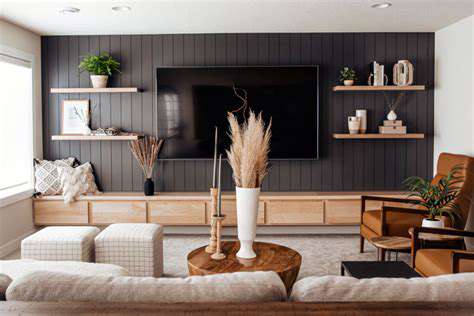How to decorate with wooden furniture in an open plan living area
Selecting a Style that Reflects Your Personal Aesthetic
Your furniture should whisper you the moment someone enters the room. Maybe it's the clean lines of Scandinavian design that calm your busy mind, or perhaps the robust curves of Arts and Crafts pieces that feel like home. Don't chase trends—select pieces that spark genuine joy when you see them each morning.
Mix eras intentionally. A mid-century credenza can anchor a space when paired with contemporary abstract art. The unifying element? Wood tones that complement rather than match exactly. Try holding fabric swatches and paint samples against different wood finishes in natural light—you'll immediately see which combinations sing.
Prioritizing Functionality and Multi-Purpose Furniture
Open-plan living demands furniture that earns its footprint. That gorgeous cabinet? It should store board games and spare linens. The coffee table? Consider one with lift-top storage for remote controls and magazines. The most successful pieces serve at least two purposes without appearing cluttered.
For work-from-home households, a console table behind the sofa transforms into an instant workstation with the right stool. By day it displays art objects; by night it becomes a productive nook. This adaptability keeps spaces feeling fresh rather than stagnant.
Creating a Visual Flow with Wooden Furniture
Choosing the Right Wood Tone
Wood tones act as visual connectors, subtly guiding the eye through your space. Light ash tones can make north-facing rooms feel sunnier, while walnut's chocolatey depths add sophistication to bright southern exposures. Test samples at different times of day—what looks warm at noon may feel dingy by evening.
Layering Textures and Patterns
Texture creates rhythm in a room. Pair smooth, lacquered side tables with a rough-hewn dining table to prevent visual monotony. When selecting fabrics, vary scales—a large geometric rug plays well with small floral pillows. This layered approach adds depth without chaos.
Strategic Placement for Visual Harmony
Arrange furniture to create natural sightlines. Position key pieces so they're visible from multiple angles—a sculptural chair glimpsed through a doorway becomes an artistic moment. Use area rugs to define zones while maintaining an overall sense of connection.
Integrating with Existing Décor
Wood furniture shouldn't compete with your architecture. If you have oak floors, consider cherry furniture for subtle contrast rather than an identical match. This creates intentional variation that feels curated rather than accidental.
Scale and Proportion for Visual Balance
Oversized furniture in small spaces creates tension, not intimacy. For rooms under 12x12 feet, choose leggier pieces that reveal floor space. The visual weight of furniture changes with color—a dark mahogany bookshelf feels heavier than a blonde birch version of the same size.
Lighting and Reflection for Enhanced Visual Impact
Position lamps to graze wood surfaces, highlighting grain patterns. A well-placed mirror can double the apparent size of a striking wood feature. For evening ambiance, install dimmers—wood looks richest under 2700K lighting.

Balancing Warmth and Modernity with Wooden Furniture

Embracing a Harmonious Blend
The magic happens when clean-lined modern pieces incorporate natural imperfections. Look for furniture with visible joinery or slight grain variations—these flaws add soul to minimalist designs. A Shaker-style bench feels unexpectedly modern when paired with a sleek glass table.
The Role of Natural Light and Materials
Morning light reveals wood's true character. Position key pieces where sunlight can animate their surfaces—a breakfast nook's maple table will glow differently than the same piece under artificial light. This daily transformation connects inhabitants to natural rhythms.
Color Palettes and Their Impact
Cool grays and warm woods create dynamic tension. Try a gray-washed oak media console against warm white walls—the combination feels fresh yet grounded. For accent colors, earthy greens and deep blues complement wood tones without overwhelming.
Strategic Use of Texture and Patterns
Modern spaces often lack textural variety. Introduce hand-carved bowls or a live-edge shelf to break up smooth surfaces. These organic elements prevent sterility while maintaining clean aesthetics.
The Importance of Furniture Selection
Invest in one showstopping wood piece per zone—perhaps a sculptural chair in the living area or a waterfall-edge console in the entry. These anchors provide warmth while letting other elements remain minimalist.
Lighting and Its Influence on the Ambiance
Pendant lights with wood accents bridge modern fixtures and traditional materials. Choose designs where wood appears sparingly—perhaps just a slim walnut ring on a metal shade. This subtle nod creates cohesion without theme-park literalism.
Maintaining a Cohesive Look Across the Open Plan
Choosing the Right Wood Tones
Limit your wood palette to three complementary tones. For example: light oak floors, medium walnut furniture, and dark ebony accents. This creates hierarchy without confusion. Samples are essential—view them vertically (like furniture) rather than flat on the floor.
Incorporating Wooden Accents
Extend the wood theme through unexpected items: a leather-bound book collection, bamboo window blinds, or even wooden switch plate covers. These subtle repetitions create subconscious harmony.
Furniture Placement and Flow
Create visual rest stops by leaving some walls bare between wood pieces. This prevents the woody equivalent of wallpaper—where everything blends into noise rather than standing out as intentional.
Texturing Variations
Pair high-gloss lacquered pieces with matte oil-finished ones. The contrast in sheens adds sophistication while maintaining material consistency. Just ensure all finishes share similar undertones.
Considering Lighting and Reflections
Position lighting to create pools of warmth. A focused beam on a wood dining table makes it the heart of the space, while softer perimeter lighting maintains overall brightness.
Matching or Contrasting Finishes
For contemporary spaces, mix wood with metal or stone. A marble-topped wood console mediates between materials elegantly. The key is ensuring all elements share similar visual weight.
Maintaining Balance with Non-Wooden Elements
Every third element should be non-wood. This might mean a linen sofa between two wood chairs, or a metal lamp on a wood side table. This rhythm prevents material fatigue while keeping wood as the dominant theme.